Ahoy, squirts! Quint here. Let me set the stage for this. I put out my feelers out a couple months back with some people at Dreamworks (with much help from mega publicist Deb Wuliger) about getting Steven Spielberg on the phone to talk Jaws, the idea being we could time it to its pending anniversary.
That was the pitch, but that was all cover. I really just wanted to talk to the director of my favorite movie of all time ABOUT my favorite movie of all time. I’m sure my ruse was as transparent as clean plate glass window (I don’t hide my geekiness very well), but the kind souls around Spielberg allowed my request to make it to him and I heard back an enthusiastic yes right before Memorial Day weekend.
We were going to schedule a time between then and June 20th, which was the latest the interview could go up as that was the anniversary of the release of Jaws in 1975, but as of Thursday afternoon I hadn’t heard anything back.
I went to the Alamo’s Super 8 marathon, which included a surprise screening of Super 8, followed by Close Encounters of the Third Kind, Scanners and John Carpenter’s The Thing and when I got home at nearly 4am I checked my email to find out Spielberg had an opening in his schedule for 12:30pm my time the next morning.
Of course I had to watch Jaws while compiling a list of questions, so that gave me a little more than 4 hours of sleep before the interview.
I went in not knowing how much time I had with Spielberg… it could have been 5 minutes or 50, I had no idea… but I was bound and determined to milk my time for as much as humanly possible.
When the words, “Eric, I’m transferring you to Steven Spielberg’s office. Please hold a moment” hit my ears I won’t lie… my nerves were on end. Could I somehow not be Chris Farley in this scenario? Was that even possible?
But, like my brief encounter with the man on the set of War of the Worlds, once the conversation began the nerves went away and I was just excited to have the opportunity to talk with Steven Spielberg about Jaws.
Now, we cover a few other things as well. The conversation occasionally splinters off to his other films, including Jurassic Park, Indiana Jones, E.T. and Close Encounters, but Jaws is the focus.
Let’s dive into this thing, shall we? Sit back, relax and enjoy the ride!
*Updated with audio clips! Search out the Amazing Sound-O-Text links for the latest in interview technology!
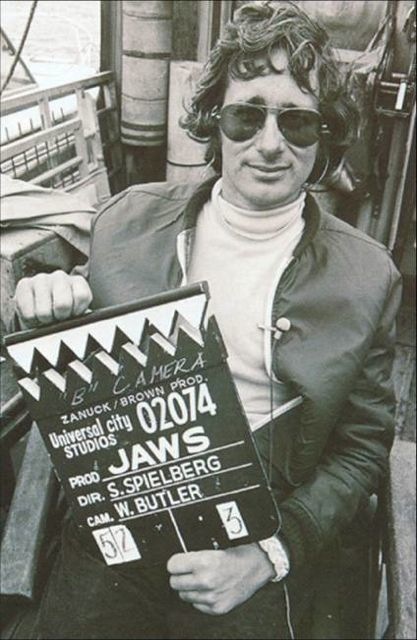
Quint: How’s it going, sir?
Steven Spielberg: Hey, Eric. How ya’ doing?
Quint: It’s going well. How’re you?
Steven Spielberg: Good! So, what’s up? Well, I know what’s up with you. I read all your stuff.
Quint: Well, I watch all your movies, so we’re even.
Steven Spielberg: Last time we talked was a long time ago, it was on the (War of the Worlds) set (You can read about that visit here and here). You did the Indy thing, too. I remember that. (Referring to this not-quite set visit gathering of geeks during the filming of Indiana Jones 4).
Quint: Yeah, the War of the Worlds set visit was the big one for me. That’s where I had my big geek out.
Steven Spielberg: (laughs) Well, I geek out, too. So don’t think it’s just you!
Quint: Of course you do. I loved that when we met on the set the first things we talked about were Ray Harryhausen and Willis O’Brien. Their influence can be felt in your films and your movies were almost gateway drugs to discovering more about their work for me.
Steven Spielberg: Well, I’m glad you’re amongst us, making us remember that every decade there’s a new trend and one trend owes legions to its predecessors.
Quint: Especially now it must be hitting you dead center seeing how your very specific visual style is being replicated by the next generation of filmmakers. I mean, JJ Abrams’ Super 8 is obviously a loving tribute to your films, down to a very specific look.
Steven Spielberg: JJ was raised in those decades of movies that all of my colleagues made and continue to make. So, JJ (was brought up in) the same way I was raised, by a decade of filmmakers who I am beholden to. So, it all comes out in the laundry.
Quint: I really appreciate you taking the time to look back at Jaws with me….
Steven Spielberg: Sure, sure.
Quint: Obviously the movie means a lot to me and going through that new making of book, Jaws: Memories From Martha’s Vineyard, it really did strike me just how important it was that you made the personality Amity that of Martha’s Vineyard. It makes Amity feel like a real town. So, I was wondering if we could talk a little bit about how you pulled so many locals into the movie and how much of that was a creative choice and how much of that was political to help you ease the troubled waters of filming on location.
Steven Spielberg: Well, I didn’t know anything about politics in those days. I was just trying to find as much naturalism to play against the basic size of the shark. I didn’t want this film to be a mythological tale and if everybody played as big as the shark weighed and measured nobody would have believed the shark was real if the people hadn’t been as real.
So, I looked to the community of Martha’s Vineyard, and also off into the Boston area, to find local people that would make the audience feel that the story was truly happening not in Hollywood, but on a fictitious island called Amity.

Quint: That was also your reasoning for wanting to actually shoot on the ocean as well, right?
Steven Spielberg: Right, exactly, because if I made the movie in a tank it would have had that same mythological feel that the Spencer Tracy film, The Old Man and the Sea, has.
Quint: Or 20,000 Leagues Under the Sea. When you see Kirk Douglas fighting a giant squid, as awesome as that is, you know they shot that on a backlot somewhere.
Steven Spielberg: Yeah, exactly. I was naïve about the ocean, basically. I was pretty naïve about mother nature and the hubris of a filmmaker who thinks he can conquer the elements was foolhardy, but I was too young to know I was being foolhardy when I demanded that we shoot the film in the Atlantic Ocean and not in a North Hollywood tank.
But had I to do it all over again I would have gone back to the sea because it was the only way for the audience to feel that these three men were cast adrift with a great white shark hunting them.

Quint: I think the real key to the fear that you put into the world populace, the fear of swimming, is the fact that it’s so obviously not just in a pool somewhere. Those creatures actually live and hunt in those waters and almost everybody has been swimming in the ocean, so there’s an easy access to that base fear.
Steven Spielberg: Right, right.
Quint: Even if the average filmgoer doesn’t know how movies are made, there’s something in their brain that clicks, that registers when something is real and sees the difference.
Steven Spielberg: That’s so true.
Quint: I know it was a headache, but I would hope looking back on it now you could say all the aggravation and stress was worth it.
Steven Spielberg: It was worth it because, for number one, Close Encounters, which was a film I had written and a film nobody seemed to want to make, everybody seemed to want it right after Jaws was a hit. So, the first thing Jaws did for me was it allowed a studio, namely Columbia, to greenlight Close Encounters. For number two, it gave me final cut for the rest of my career. But what I really owe to Jaws was creating in me a great deal of humility, about tempering my imagination with just sort of the facts of life.
CLICK HERE TO FOLLOW ALONG WITH THE NEXT BIT IN AMAZING SOUND-O-TEXT!
That movie was more than just a filmmaking and eventually a filmgoers experience, that movie was all about human relationships both in front of and behind the scenes because people started to lose their noodles as we spent weeks and then many months on Martha’s Vineyard and then, later, in the Pacific Ocean around Catalina. It took its toll. It feels like half my work was talking people off the ledge, when cast and crew had no idea when we’d ever leave Martha’s Vineyard, when people could return to their wives and families and real lives. They kept turning to me saying, “When are you going to finish the movie?” I kept saying, “Ask Mother Nature! I don’t know! Ask the tides!”
What was going down was not human error, it was just the conditions at sea that made it untenable to really be doing what we were somehow doing. Everything on land went normal! Everything I shot on any form of land went like a normal movie. I actually was on schedule for the first part of the picture. I mistakenly blew all my cover; the scenes I could have held back in case there was a mechanical problem with the shark, in case there was a bad day at sea and we couldn’t shoot because of the height of the waves or the strength of the wind. I foolishly didn’t have enough cover to be able to go back to the shore to keep shooting the shore portions of Jaws and that was completely my fault and no one else’s.
So, when we were shut out many days because of mechanical problems and weather problems, all we could do was wait and bounce up and down on the waves and watch each other vomiting over the side.
Quint: Correct me if I’m wrong here, but you also used that time to come up with some creative workarounds and to flesh out the script, right.
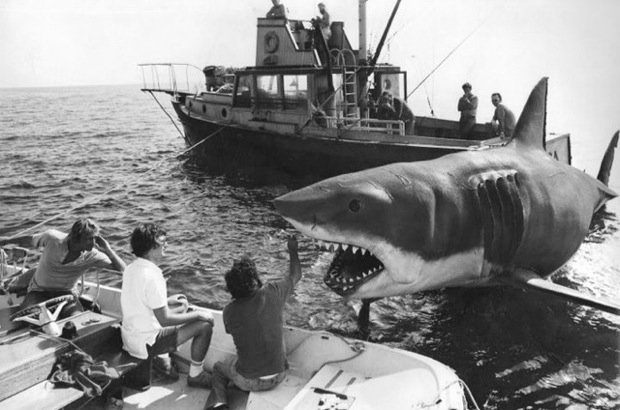
CLICK HERE TO FOLLOW ALONG WITH THE NEXT BIT IN AMAZING SOUND-O-TEXT!
Steven Spielberg: Yeah, it’s true. The shark not working was a godsend. It made me become more like Alfred Hitchcock than like Ray Harryhausen in the sense that Ray Harryhausen in his day could do anything he wanted because he had control of his art. When I didn’t have control of my shark it made me kind of rewrite the whole script without the shark. Therefore, in many people’s opinions the film was more effective than the way the script actually offered up the shark in at least a dozen more scenes that today is history.
Quint: Losing that creative thinking is something that worries me today when I see so many filmmakers using CG as a crutch. I worry that we lose some of give and take that often times forces creativity. I don’t know if you think about that at all now…
Steven Spielberg: I think that CG is a tool that often becomes a weapon of self-destruction. I certainly have done my share of CG since I was at the forefront of the revolution as a producer of YOUNG SHERLOCK HOLMES, that had the first CG shot ever, and then JURASSIC PARK that the first CG characters ever. Jim Cameron in-between did brilliant CG work on THE ABYSS and then T2…
I’ve actually suffered from the wealth of riches that CG can give a filmmaker to almost over use the technology to get everything out of our brains and on to the screen when sometimes what’s fun is being denied your best ideas and then you’ve got to fall back on a compromise, which often turns out to be an even better idea. I fall victim to that, too.
Quint: I have to say that to this day, for whatever reason… perhaps the combination of the digital effects and Stan Winston’s dinosaurs, but when I watch Jurassic Park I don’t see the CG.
Steven Spielberg: That’s a testament to Dennis Muren, to Phil Tippett and to Stan Winston because the blend between… I mean, 65% of the first Jurassic Park is Stan Winston. I believe there’s only between 58 and 60 digital shots in the whole movie. That’s it. The sequel, that I directed, there were four times more digital shots than that.
In the first film it was actually Stan Winston actually working together with Dennis Muren putting their heads together to try to figure out how to make these blends from mechanical full-sized puppeteering to the digital wider shots.
Quint: Not to diverge too much into Jurassic Park, but there’s something to the personality of the dinosaurs as well. Look at the Raptor scene in the kitchen, for instance. The Raptors have a very stop motion quality, they remind me a lot of Ray Harryhausen’s creatures.
CLICK HERE TO FOLLOW ALONG WITH THE NEXT BIT IN AMAZING SOUND-O-TEXT!
Steven Spielberg: What Ray Harryhausen did, and Ray’s always been a humongous influence on my work and I was so honored to be able to show Ray Harryhausen the very first digital shot that Dennis Muren cranked out as a test. Ray happened to be visiting me that day and I said, “Ray, do you want to see a CG dinosaur?” He said, “Sure,” so he went over to the art department where I was prepping Jurassic Park and I put on the three-quarter inch cassette into the big machine and Ray and I watched the Gallimimus (scene). They were all just rendered as skeletons, they had not been fleshed, but the movement was so smooth that I just got to watch Ray Harryhausen’s face watching the natural evolution from his art to the new era of digital characters.
Harryhausen embraced it immediately as a positive. He wasn’t sad to see the paradigm shift; he was a jubilant as you can imagine a young boy would be. I saw the child in him at that moment, which was for me one of the greatest moments of my life; looking into his eyes as he was watching what Dennis Muren had created.
Quint: I can imagine, man.
Steven Spielberg: What was I talking about before I went into my Ray Harryhausen fugue state? What I was saying was I was inspired by Ray Harryhausen because a lot of Ray Harryhausen’s characters stalked the humans. They just kind of like stalked them and they got into these frozen poses of real frightening imagery. I remembered that and so did Dennis Muren and so did Phil Tippett who really helped Dennis create dinosaurs that were natural and not cinematic.
I always brought the guys back to Ray Harryhausen because he was the one whose characters did such a scary job stalking all the humans in those big tableaus.
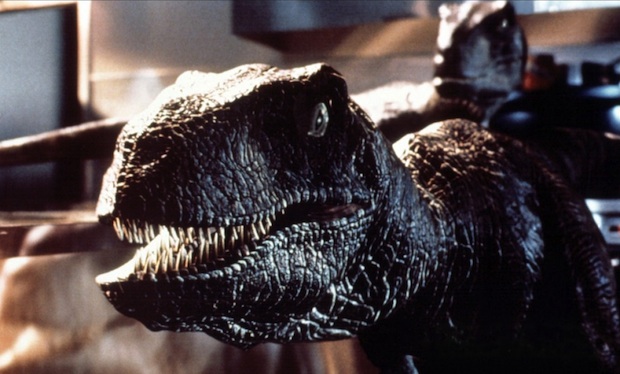
Quint: If you’re able to give a personality to your creatures that gets you 9/10ths of the way there. Once there’s a personality there it doesn’t feel like an effect.
Steven Spielberg: Right.
Quint: But let’s go back to Jaws. We have to talk about the casting of your leads. You must have sweated that a little bit because if the chemistry between your Quint, Brody and Hooper was flat then the whole second half of your movie doesn’t work.
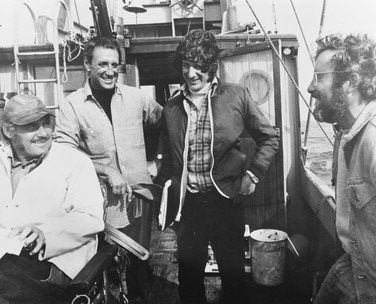
Steven Spielberg: That’s true. Casting sometimes is fate and destiny more than skill and talent, from a director’s point of view. First I went to Lee Marvin and he said no. Then I went to Sterling Hayden and he said no. Then finally David Brown, who had just worked with Robert Shaw on The Sting, and said “What about Robert Shaw?” I said, “David, you’re a genius!” And Robert said yes. That was a simple story, although it took six months to cast Quint.
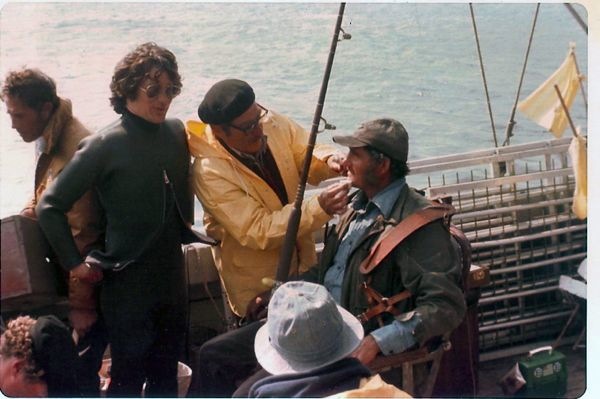
And I went to several actors before Roy Scheider. They didn’t turn me down, I just had decided they were not right for the part. I tested dozens of possible Brodys. I don’t want to mention any names because many of them are still with us.
But I was at a party at Andre Eastman’s house and I met Roy Scheider for the first time. He walked over to me and I was literally sitting on a couch with a Coca-Cola in my hand fretting over Jaws, that I wasn’t able to get this shark movie cast, and Roy sat down and introduced himself. Of course, I had loved him so much in The French Connection and then in The Seven Ups. Roy actually said to me, “You have such a glum look on your face. What’s the matter?” I said, “Aw, I’m having trouble casting my picture.” He actually said, “Who have you gone out to?” I named a few names and looked at me and said, “What about me?!?” He actually said, “What about ME?!?” in only the way Roy could do that, with his voice kind of cracking the way it does when he hits that high note.
I looked at him and said, “You’re right! What about you? Will you make my movie?” Without even asking for a script he said, “Of course! If you want me, I’ll do it!” And we actually agreed at a party that he would play Brody… that night… at Andre Eastman’s house. And then he read the script and loved it, which was good because he could have read the script and thrown it back in my face. But he loved it.
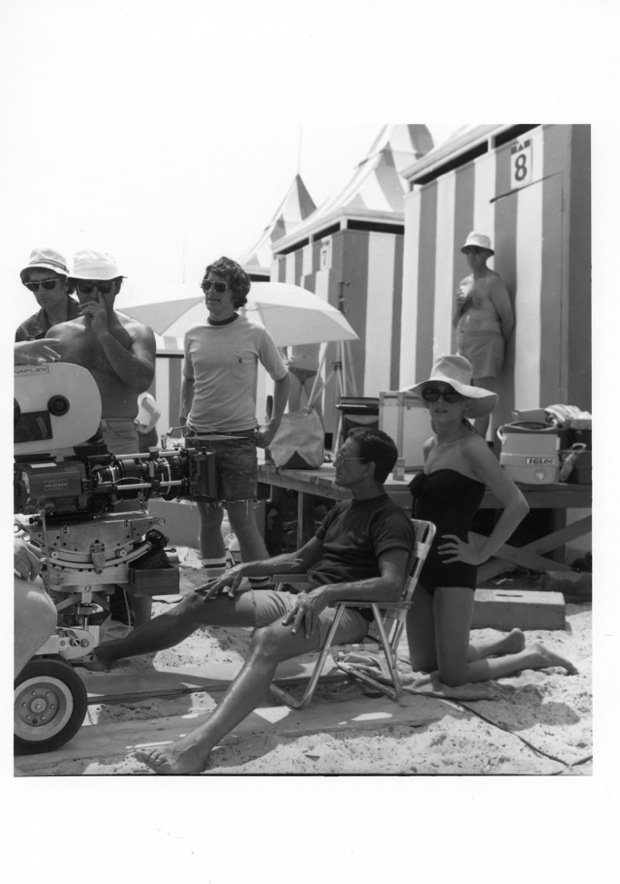
And Richard Dreyfuss was my first choice. Richard Dreyfuss and Lorraine Gary were both my first choices and they said yes when I asked, so that was all good.
Quint: What’s great about the three leads of Jaws… it’s such a perfect product of its time. Those were guys who were both leading men and character actors. They still exist today, but it’s much rarer to find that combination. It was much more common to see character actors getting to top the bill in the ‘70s and, again, with those guys in the lead the movie automatically has kind of reality, so you buy the shark. That’s something I’ve noticed you’ve done on a lot of your movies, you cast really interesting people in your lead roles.
Steven Spielberg: Well, people who are at least touchstones to the human race, that anybody can identify with and say, “That could be me.” That’s all I look for in a movie that I go to see as an audience. Is there any character in the film that I can identify with; that I can experience these events through their eyes. That’s all I’m looking (for), somebody I can believe in.
Harrison Ford, who is iconic now, was so full of vulnerabilities in both Star Wars as Han Solo as well as then casting him as Indiana Jones, even though he was a big hero with a whip and a resolve to achieve all of us could identify with him. He wasn’t so out of reach that nobody could believe they never could become him.
Quint: You also beat the shit out of him in that first movie! (laughs)
Steven Spielberg: Yeah, exactly! That also helps the audience say that within some of the campiness of some of these set pieces there’s a great deal of character reality going on in the way he’s being batted around by the bad guys!
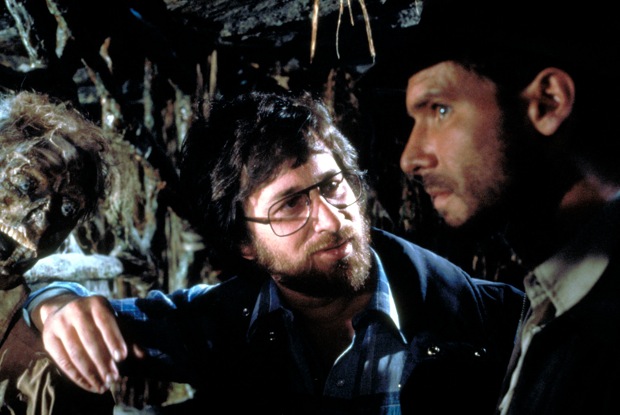
Quint: I’ve read that this is one of your favorite scenes in Jaws… The Indianapolis Speech in Jaws floors me every single time I watch the movie. If I even hear Robert Shaw start that speech I’m zoned in and nothing else exists in the universe, you know? So, do you remember shooting that scene? What was the vibe on the set? Was it weighty?
CLICK HERE TO FOLLOW ALONG WITH THE NEXT BIT IN AMAZING SOUND-O-TEXT!
Steven Spielberg: We shot it twice. The first time we attempted to shoot it Robert came over to me and said, “You know, Steven, all three of these characters have been drinking and I think I could do a much better job in this speech if you let me actually have a few drinks before I do the speech.” And I unwisely gave him permission.
He went into the Whitefoot, which was a big sort of support boat that we always took our lunch breaks on and all the bathrooms were on that boat, it was a big tug boat, and he went into the hold with my script girl Charlsie Bryant and I guess he had more than a few drinks because two crew members actually had to carry him onto the Orca and help him into his chair. I had two cameras on the scene and we never got through the scene, he was just too far gone. So, I wrapped the company at about 11 o’clock in the morning and Robert was taken back to his house on Martha’s Vineyard.
At about 2 o’clock in the morning my phone rings and it’s Robert. He had a complete blackout and had no memory of what had gone down that day. He said, “Steven, tell me I didn’t embarrass you.” He was very sweet, but he was panic-stricken. He said, “Steven, please tell me I didn’t embarrass you. What happened? Are you going to give me a chance to do it again?” I said, “Yes, the second you’re ready we’ll do it again.”
The next morning he came to the set, he was ready at 7:30 out of make-up and it was like watching Olivier on stage. We did it in probably four takes.
Quint: It’s an electrifying moment. And one thing that I notice, if I’m ever able to break my attention away from Shaw himself, is just how spellbound Dreyfuss looks in that scene. That’s not acting. I can clearly tell that he’s enraptured by the performance he’s watching, just as much as I am.
Steven Spielberg: I think we were all watching a great performance and the actors on camera were watching a great performance; Roy and Richard. Richard was in all the shots because Roy was in a cutaway in a separate part of the cabin of the boat, but obviously on Richard’s face… you can see Matt Hooper in character, but you can also see Richard Dreyfuss in complete awe and admiration of this great actor.
Quint: It’s one of my favorite scenes in the history of cinema.
Steven Spielberg: I owe three people a lot for this speech. You’ve heard all this, but you’ve probably never heard it from me. There’s a lot of apocryphal reporting about who did what on Jaws and I’ve heard it for the last three decades, but the fact is the speech was conceived by Howard Sackler, who was an uncredited writer, didn’t want a credit and didn’t arbitrate for one, but he’s the guy that broke the back of the script before we ever got to Martha’s Vineyard to shoot the movie.
I hired later Carl Gottlieb to come onto the island, who was a friend of mine, to punch up the script, but Howard conceived of the Indianapolis speech. I had never heard of the Indianapolis before Howard, who wrote the script at the Bel Air Hotel and I was with him a couple times a week reading pages and discussing them.
Howard one day said, “Quint needs some motivation to show all of us what made him the way he is and I think it’s this Indianapolis incident.” I said, “Howard, what’s that?” And he explained the whole incident of the Indianapolis and the Atomic Bomb being delivered and on its way back it was sunk by a submarine and sharks surrounded the helpless sailors who had been cast adrift and it was just a horrendous piece of World War II history. Howard didn’t write a long speech, he probably wrote about three-quarters of a page.
But then, when I showed the script to my friend John Milius, John said “Can I take a crack at this speech?” and John wrote a 10 page monologue, that was absolutely brilliant, but out-sized for the Jaws I was making! (laughs) But it was brilliant and then Robert Shaw took the speech and Robert did the cut down. Robert himself was a fine writer, who had written the play The Man in the Glass Booth. Robert took a crack at the speech and he brought it down to five pages. So, that was sort of the evolution just of that speech.
Quint: I’d love to read the 10 page Milius version.
Steven Spielberg: I don’t think it exists. I know I don’t have it. I’ve been asked for it, everybody has been wanting to see it and John doesn’t have it because in those days we didn’t have computers, we didn’t have hard drives, it was just on pieces of paper!
I remember just saying, “Hey, this is a movie! Somebody someday should do a movie just about the Indianapolis.”
But the other lucky thing about the shark not working was that we all did have a chance to hone the script and do improvisations and then Carl Gottlieb took the improvisations that I tape recorded and transcribed them, then he structured scenes and then we’d all collaborate with Carl on cutting the scenes down, making them short enough to still put into the movie and let the movie have its own narrative pace.
But Carl made great contributions to the movie. I brought him to Martha’s Vineyard to do comedy punch-up work because he’s a very funny guy, a very funny writer, and he wound up really staying there a long, long time helping all of us with all of the scenes, so Carl did deserve his credit and did great work on Jaws. I’m very beholden to Carl for sticking it out as long as he did with us because that was a lonely island for everybody making that movie over many months.
Quint: Your filmmaking style at that time is very recognizable. It seemed with both Duel and Jaws you’re developing a very iconic style that we started talking about at the beginning of the interview. You used a lot of split-diopter shots, had a lot of overlapping dialogue… it was a very naturalistic style. What is it that drew you to that kind of technique?
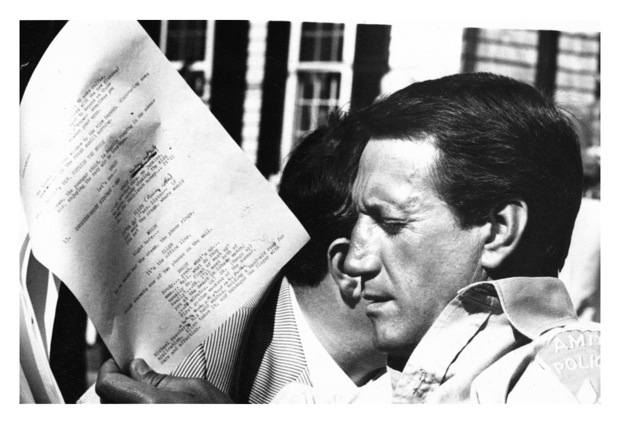
Steven Spielberg: That technique for me was always just the way I always observed people having conversations in daily life. I always wondered why movies couldn’t have more naturalism in them; why scenes couldn’t be hybrid scenes between the documentary and the drama.
Robert Altman, of course, made it a fine art: background conversations and foreground conversations and even some midground conversations. Altman probably reached his nexus with that with Nashville, which I think is the best movie Altman made. And I was very influenced, I think, by Altman’s MASH. There’s naturalism in that and yet it’s such a bizarre comedy at the same time. It was realistic because it was about the Korean War, but then it was zany and madcap and he was able to temper all that in a kind of pseudo-documentary style.
I did not want to do a pseudo-documentary style for Jaws ‘cause I wanted Jaws to be a big, slick commercial looking movie, but I needed something to offset the surreality of the shark. The more natural I could make the performances in the foreground I thought the more people would swallow the weight and size of that great white.
Quint: Here’s another thing, though. When you…
Steven Spielberg: Oh, and by the way… Let me say one more thing, Quint.
Quint: Sure, sure.
Steven Spielberg: The more fake the shark looked in the water, at least to the crew watching it being hauled behind a speedboat, the more my anxiety told me to heighten the naturalism of the performances.
Quint: Here’s the thing… what makes horror movies scary… Jaws is always described as a horror movie, but I see it as more of a men on a mission/adventure story…
Steven Spielberg: I agree with you.
Quint: Good, I’m not the only one! But what makes tension work, be it in a thriller or horror film, is when you care for the people in jeopardy. If you’re scared of losing somebody you like then the filmmaker has you. I mean, Quint’s death is so inevitable from the very beginning, the whole Ahab parallel of one’s obsession getting the best of him, but you don’t want him to go. You’re scared when Hooper goes in the water. Hell, you’re scared when Alex Kintner goes into the water and we’ve spent all of 30 seconds with him.
Steven Spielberg: Right, right.
Quint: That naturalistic approach and your casting absolutely worked. You relate to the people in danger. It’s not just sexy supermodels in bikinis wading into the surf, it’s a kid that could be your nephew.
Steven Spielberg: And yet Quint, who is a bigger than life character required a bigger than life death scene, so I was able to mythologize a character like Quint where that death would have been an earned one, you know what I’m saying?
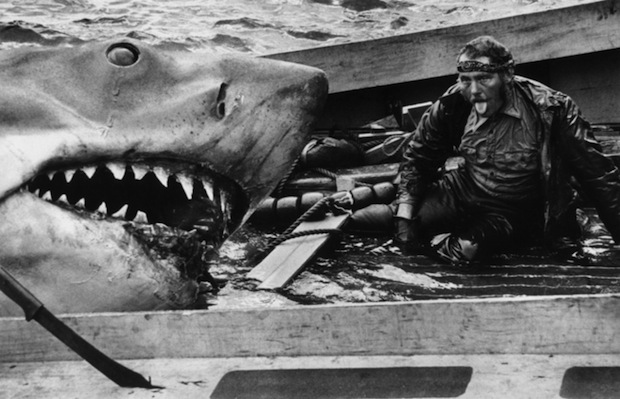
Quint: Absolutely. I never doubted it once and it really freaked me out as a kid. It was two things: when he spits up that bright red blood and when we next see the shark he has bits of Quint hanging off his teeth.
Steven Spielberg: Exactly! Exactly because sharks don’t have toothpicks! There was a lot of raw chicken that contributed to that sequence.
Quint: Now, they must have asked you to come back for Jaws 2…
Steven Spielberg: Yeah, of course. Of course. And Jaws 3. I was done, I was done with the ocean. I would have done the sequel if I hadn’t had such a horrible time at sea on the first film. I would have absolutely jumped at the chance to own the sequel because I knew that when I was walking away from the sequel I was walking away from a huge piece of my life that I had helped to create, but it wasn’t a hard decision to walk way from it. I just could not imagine going back out to the ocean and sitting in a boat for 9 months. I just couldn’t imagine it.
So, I was happy and relieved not to have made the movie, but also I wasn’t happy with the sequel and I realized I had let a franchise go that I could have made a good contribution to.
Quint: Do you have any idea what you would have done with a sequel?
Steven Spielberg: No, no idea at all, but I have a very, very good scene which I thought would have been good for a sequel someday, which I will tell you someday because I don’t want it in print.
Quint: Okay.
Steven Spielberg: But I’ll tell you my scene some day. Every time I think of this scene I think, “Hmmm, could this be another Jaws movie?” and I have to immediately stop myself and immediately pull myself back down to Earth.
Quint: I will turn this digital recorder off right now.
Steven Spielberg: I’ll tell you some day. We don’t talk enough, we’re going to have to talk more. I’ll tell you some day.
Quint: Alright, just remember that!
Steven Spielberg: I will! I won’t forget it! I promise, I promise!
Quint: Is there a Jaws Blu-Ray in the works?
Steven Spielberg: Yes, there is. Yes, there is. I’ve already seen some of it. I don’t have a date yet, but there’s a Blu-Ray absolutely in the works.
Quint: I can’t wait, man. I love that the last DVD release actually had the original mono soundtrack on it as well. I wasn’t a fan of the remixed 5.1 sound… the splashing sounded canned and the gunshots were changed…
CLICK HERE TO FOLLOW ALONG WITH THE NEXT BIT IN AMAZING SOUND-O-TEXT!
Steven Spielberg: Oh, I know. I totally understand that. (In the future) there’s going to be no more digital enhancements or digital additions to anything based on any film I direct. I’m not going to do any corrections digitally to even wires that show.
If 1941 comes on Blu-Ray I’m not going to go back and take the wires out because the Blu-Ray will bring the wires out, that are guiding the airplanes down Hollywood Blvd. At this point right now I think letting movies exist in the era, with all the flaws and with all of the flourishes, is a wonderful way to mark time and mark history.
Quint: I’m in total agreement with you. I wish you could talk George (Lucas) into doing the same thing!
CLICK HERE TO FOLLOW ALONG WITH THE NEXT BIT IN AMAZING SOUND-O-TEXT!
Steven Spielberg: Well, I can’t!
Quint: (laughs) Yeah, I don’t think anybody can!
Steven Spielberg: George goes his own way and I respect him for it, but my new philosophy about this is to let sleeping dogs lie.
Quint: That’s great news for film geeks. Anybody who appreciates film, that's like music to their ears.
Steven Spielberg: When people ask me which E.T. they should look at, I always tell them to look at the original 1982 E.T. If you notice, when we did put out E.T. we put out two E.T.s. We put out the digitally enhanced version with the additional scenes and for no extra money, in the same package, we put out the original ‘82 version. I always tell people to go back to the ’82 version.
Quint: Having the option is the big deal for me. Using the Star Wars example, I don’t think there’d be an outcry if we could watch a nice transfer of the original versions. We’d be like, “George can do what he wants and I’ll watch it… but you know maybe the fans would like the option of watching the movie they fell in love with, too.”
Steven Spielberg: Yeah. And I think the other good thing is that they understand when they see a movie and they suddenly see something that could have been done much better today and could have been corrected in the DVD/Blu-Ray transfer, they really appreciate seeing the strings attached.
If somebody put out George Pal’s War of the Worlds and took the strings off the machines I’d be very upset. When that machine crashes in downtown Hollywood, and you see the strings going from taut to slack, that’s the thing that allows me to both understand this movie is scaring the hell out of me and at the same time this movie is a creation of the human race.
That little taut-to-slack moment of those wires on that wingtip makes the original George Pal War of the Worlds work for me. It embraces my fears and it also alleviates them in the same breath.
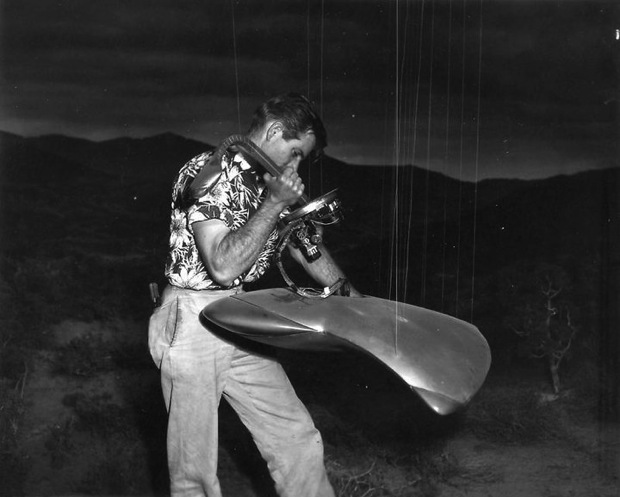
Quint: I notice you don’t do commentaries on your films. Is there a reason for that?
Steven Spielberg: Well, because if I do commentaries it takes you out of the movie. It just takes you totally out of the movie because you’re not really watching a movie, you’re listening to a radio show. So, I’ve just never believed in doing commentaries because once people start one of my movies I want them to get into the film. I don’t want to knock down the fourth wall for them and take them into the handbook of how I did it because I just think it breaks the illusion.
Quint: Now, I’ve heard a story that I wanted to run by you. I have no idea if it’s true, but an effects friend of mine told me about a special screening of E.T. for Ronald Reagan. Have you heard this story?
CLICK HERE TO FOLLOW ALONG WITH THE NEXT BIT IN AMAZING SOUND-O-TEXT!
Steven Spielberg: I was there!
Quint: The story I heard is that when Reagan saw it he started talking about how close to reality it was and he was quickly ushered out of the room. Is that true?
Steven Spielberg: No, he wasn’t ushered out of the room. He was the President of the United States! Nobody could usher Ronald Reagan out of the room! It was in the White House screening room and Reagan got up to thank me for bringing the film to show the President, the First Lady and all of their guests, which included Sandra Day O’Connor in her first week of as a Justice of the Supreme Court, and it included some astronauts… I think Neil Armstrong was there, I’m not 100% certain, but it was an amazing, amazing evening.
He just stood up and he looked around the room, almost like he was doing a headcount, and he said, “I wanted to thank you for bringing E.T. to the White House. We really enjoyed your movie,” and then he looked around the room and said, “And there are a number of people in this room who know that everything on that screen is absolutely true.”
And he said it without smiling! But he said that and everybody laughed, by the way. The whole room laughed because he presented it like a joke, but he wasn’t smiling as he said it.
The room did laugh and then later on I’ll never forget my conversation with the President. He pulled me aside, he said… and I can’t do Reagan. I wish I could do that breathy, wonderful voice of his… And Nancy Reagan was standing right next to him and the President said to me, “I only have one criticism about your movie,” and I said “What’s that?” He said, “How long were the end credits?” I said, “Oh, I don’t know. Maybe three, three and a half minutes?” He said, “In my day, when I was an actor, our end credits were maybe 15 seconds long.”
He said, “Why don’t you let everybody get a credit… three and a half, four minutes, that’s fine, but only show that inside the industry, but throughout the rest of the country reduce your credits to 15 seconds at the end?” Nancy Reagan turned to him and said, “Oh, Ronny, they can’t do that. You know that.” And he went, “Oh, yes, yes. I suppose.” (laughs) That was the extent of my conversation about that . That was his only criticism, he felt the end credits were too long!
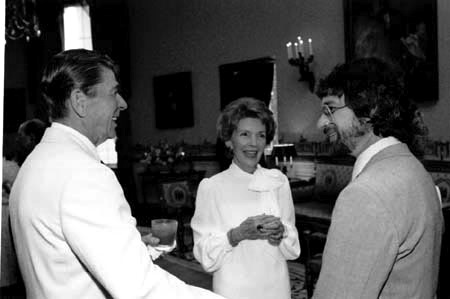
Quint: So, do you think he actually let something slip there?
Steven Spielberg: I don’t think he let something slip there, no. I think he delivered a joke without smiling, without a little bit of a twinkle behind the joke. I think the joke landed because everybody laughed, but because I’m a little bit of a Ufologist I was hoping that there was something more to the joke than met my eye. I’m sorry to say I think he was simply trying to tell a joke.
Quint: Cool, man. I think that’s about all I got.
Steven Spielberg: Okay! When can I read this?
Quint: It’ll be posted as soon as I can possibly get it ready.
Steven Spielberg: I can’t wait, I can’t wait!
Quint: Before I let you go, I do want to say that you need to quit beating up so much on Temple of Doom. I love that movie.
Steven Spielberg: You know, sometimes I can’t help myself. But the greatest thing about Temple of Doom was I met Kate Capshaw and I have seven children. We’ve been married for almost 20 years and that was my win on that movie.
Quint: I met Kate very briefly at the War of the Worlds premiere in New York and I made sure to tell her “I know you probably don’t get it enough, but you’re great in Temple of Doom.”
Steven Spielberg: You’re sweet. By the way, she is great in Temple of Doom and I’m very, very lucky to have found my life partner.
Quint: I love that movie because it’s so dramatically different from Raiders. The tone is different, you go from a suave villain in Belloq to a flashy villain in Mola Ram…
Steven Spielberg: Right. Here’s the thing… for all the fans of Temple of Doom who think I beat up too much on it, those fans who beat up on George Lucas 24/7 at the drop of any fedora, I would just say please give George credit. He’s the one that made it dark, he’s the one that decided on the story and on the concept. For all those who love Temple of Doom, you’ve gotta give George credit.
Quint: I’ll absolutely give George credit for that.
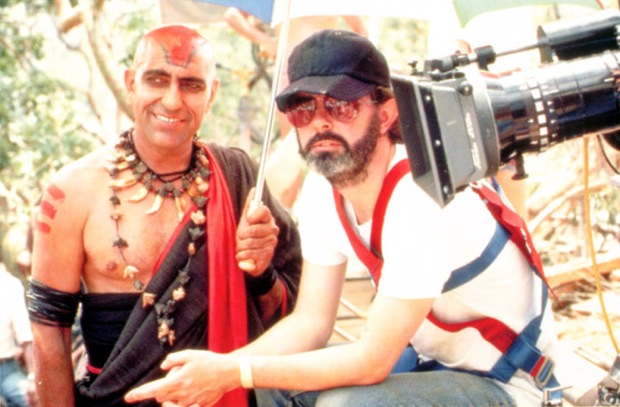
Steven Spielberg: Okay, good!
Quint: Thank you so much, sir.
Steven Spielberg: Thanks. It was good talking to you again. Don’t be such a stranger!
Quint: Whenever, man. I could talk your ear off 24/7.
Steven Spielberg: I could talk to you the same way. I really appreciate this.
Quint: No worries.

I’m not going to lie, there was a little dead space and some fumbling that I edited out when he started off the conversation with “I read all your stuff.” I’m sure he was just being nice, but fuck me if that didn’t throw me for a loop for a few seconds.
I had the time of my life conducting this chat and I hope you guys enjoyed it, too. I loved that E.T. Reagan screening story, I loved hearing the definitive word on the Indianapolis Speech and I loved his newfound philosophy on tinkering with his older films.
A massive thanks to Deb Wuliger, Kristin Stark and everyone in Spielberg’s office for making this happen. And, of course, to Mr. Spielberg himself for setting aside nearly an hour of his surely hectic schedule to look back at Jaws with a nerd like me. Happy 36th Birthday, Jaws!
Now I pack for a trip to LA where I’ll be bringing you some coverage of the Hero Complex Film Festival, including a Warren Beatty Q&A for Dick Tracy, Richard Donner for Superman 1 and 2 and some other goodies.
Next interview you’ll see from me is an AICN Legends interview with another one of my favorite directors, Mr. John Carpenter. Stay tuned!
-Quint
quint@aintitcool.com
Follow Me On Twitter

